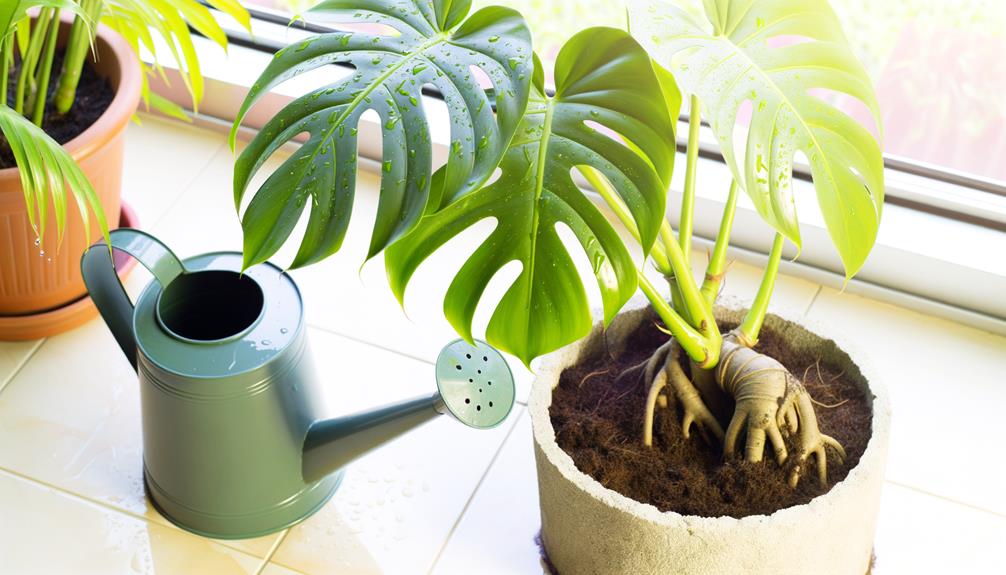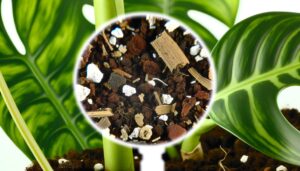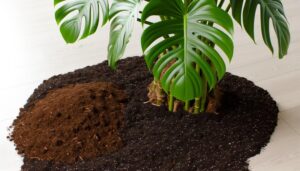Monstera Siltepecana Watering Guide
To water your Monstera Siltepecana effectively, maintain consistent soil moisture without causing waterlogging. During the growing season, water every 7-10 days and reduce this frequency to once every 2-3 weeks in winter.
Preferred water types include filtered, distilled, or rainwater to avoid chlorine and fluoride damage. Signs of overwatering include yellowing leaves and root rot, while underwatering leads to leaf tip browning and dehydration.
Adjust watering based on seasonal humidity and temperature changes. Guarantee well-draining soil with a mix of peat moss, perlite, and pine bark, and monitor the soil moisture regularly.
Continue to master these aspects for optimum growth.

Key Takeaways
- Water Monstera Siltepecana every 7-10 days during the growing season, reducing to once every 2-3 weeks in winter.
- Ensure soil moisture is even but avoid waterlogging; let the top inch of soil dry before watering again.
- Use filtered, distilled, or rainwater to prevent leaf burn and browning from chlorine and fluoride in tap water.
- Improve drainage with a well-draining soil mix containing peat moss, perlite, and pine bark, and use pots with adequate drainage holes.
- Increase humidity to 60%-80% using humidifiers, misting, pebble trays, or by grouping plants together.
Understanding Monstera Siltepecana
Monstera Siltepecana, a species within the Araceae family, exhibits unique fenestrated leaves that change from juvenile to mature stages, requiring careful study to understand its specific botanical characteristics.
You'll notice that in its juvenile phase, the leaves are smaller, solid, and have a silvery sheen. As it matures, the leaves develop fenestrations (natural holes) and increase in size, revealing the plant's climbing nature.
It's essential to provide adequate support, such as a moss pole, to mimic its natural climbing habitat. The plant's epiphytic tendencies mean it often grows on other plants in the wild, deriving nutrients from the air and rain.
Understanding these growth patterns is necessary for proper care and best health.
Ideal Watering Frequency
Understanding the plant's epiphytic nature and growth patterns, you'll need to customize the watering frequency to ensure Monstera Siltepecana thrives in your environment. This plant prefers a balance between moisture and airiness in the substrate.
Follow these guidelines to optimize watering:
- Soil Moisture: Guarantee the soil is evenly moist but not waterlogged. Check soil moisture levels using a hygrometer.
- Watering Interval: Water every 7-10 days during the growing season. Adjust frequency based on indoor humidity and temperature.
- Dormant Period: Reduce watering frequency in winter to once every 2-3 weeks, allowing the topsoil to dry out.
- Signs of Under/Overwatering: Monitor for yellowing leaves (overwatering) or curling, browning edges (underwatering).
Best Water Types
When choosing the best water for your Monstera Siltepecana, consider the potential effects of tap water, which often contains chlorine and fluoride, potentially harmful to the plant.
Using filtered water can mitigate these chemical additives and provide a more stable pH balance.
Tap Water Considerations
Choosing the right type of water for your Monstera Siltepecana can greatly impact its health, with distilled, rain, and filtered water being best choices due to their absence of harmful contaminants and balanced mineral content. Tap water often contains chlorine, fluoride, and heavy metals, which can stress your plant.
Here are considerations:
- Chlorine and Chloramine: Commonly added to tap water for disinfection, these chemicals can cause leaf burn and root damage.
- Hard Water: High in calcium and magnesium, it can lead to mineral buildup in the soil, affecting nutrient absorption.
- pH Levels: Tap water pH can vary, potentially disrupting the soil's pH balance and nutrient uptake.
- Fluoride: Can accumulate in the soil, leading to leaf tip browning and overall plant stress.
Filtered Water Benefits
Using purified water for your Monstera Siltepecana guarantees a decrease in harmful pollutants such as chlorine, heavy metals, and excessive minerals, thereby promoting peak plant health and growth.
Purified water typically undergoes processes like activated carbon filtration, which adsorbs chlorine and organic compounds, and ion exchange, which removes heavy metals like lead and copper. By eliminating these pollutants, you reduce the risk of phytotoxicity and ensure that the plant's root system can efficiently uptake essential nutrients.
Additionally, excessive minerals like calcium and magnesium, common in hard water, can lead to soil salinity and nutrient imbalances. Choosing purified water ensures that the soil pH remains stable, fostering an optimal environment for photosynthesis and overall plant well-being.
Signs of Overwatering
When overwatering Monstera Siltepecana, you'll notice yellowing leaves due to chlorosis, indicating impaired chlorophyll synthesis.
Root rot manifests through mushy, blackened roots, caused by anaerobic conditions and pathogenic fungi proliferation.
Additionally, consistently high soil moisture levels can suffocate roots, impeding oxygen uptake and nutrient absorption.
Yellowing Leaves Appearance
Yellowing leaves on a Monstera Siltepecana typically indicate overwatering, leading to root hypoxia and subsequent chlorosis. When roots are deprived of oxygen, they can't effectively transport nutrients, causing the leaves to lose their green pigment.
You should immediately examine your watering habits and drainage system. Here are key steps to address yellowing leaves due to excessive watering:
- Check Soil Moisture: Confirm the top 2 inches of soil are dry before the next watering.
- Improve Drainage: Use well-draining soil and pots with drainage holes to avoid waterlogging.
- Reduce Watering Frequency: Modify your watering schedule according to the plant's needs and environmental conditions.
- Monitor Environmental Factors: Guarantee adequate light and ventilation to assist soil drying.
Root Rot Indicators
If your Monstera Siltepecana shows dark, mushy roots with a foul odor, it's a clear sign of root rot caused by overwatering. These symptoms indicate the anaerobic conditions that facilitate the proliferation of pathogenic fungi and bacteria. Noticeable symptoms include chlorosis, wilting, and stunted growth.
| Symptom | Cause |
|---|---|
| Dark, mushy roots | Anaerobic conditions |
| Foul odor | Bacterial/fungal activity |
| Chlorosis | Impaired nutrient uptake |
| Wilting | Root system dysfunction |
Root rot disrupts the plant's ability to uptake water and nutrients, leading to systemic health decline. You should act promptly to mitigate these issues, as prolonged exposure can be fatal. Remember, understanding these indicators will help you maintain the best care for your Monstera Siltepecana.
Soil Moisture Levels
Excessive soil moisture levels in your Monstera Siltepecana can be identified by consistently soggy soil, which inhibits proper oxygenation of the root system. This anaerobic environment fosters pathogenic fungi, leading to root rot and plant decline.
To diagnose overwatering issues, look for these signs:
- Yellowing Leaves: Chlorosis occurs as waterlogged roots fail to uptake essential nutrients.
- Wilting: Despite ample water, the plant may wilt due to impaired root function.
- Mold Growth: Fungal hyphae on the soil surface signal excessive moisture.
- Foul Odor: Decomposing organic matter emits a distinct, unpleasant smell.
Signs of Underwatering
One of the primary indicators of underwatering in Monstera Siltepecana is the curling of leaves as the plant struggles to conserve moisture. When you notice the foliage curling inward, it's a physiological response to minimize water loss through transpiration.
Additionally, you'll see leaf edges turning brown and crispy, a symptom of cellular dehydration. The plant's growth rate will decelerate, and new leaves might emerge smaller than usual.
Another sign is the soil pulling away from the pot's edges, indicating severe dryness. Check the substrate's moisture content using a hygrometer to confirm.
Underwatering stresses the plant, impairing photosynthesis and overall essentiality. Promptly adjust watering practices to restore ideal hydration and prevent long-term damage.
Seasonal Watering Adjustments
To optimize Monstera Siltepecana's health, you must adjust your watering regimen according to seasonal variations, guaranteeing the plant's hydration needs align with environmental changes. Seasonal shifts affect transpiration rates, soil moisture retention, and metabolic activity.
Here's how to fine-tune your watering schedule:
- Spring and Summer: Increase watering frequency. Higher temperatures and longer daylight hours accelerate transpiration. Assure the top inch of soil remains moist.
- Fall: Gradually reduce watering. Decreasing light and cooler temperatures slow down the plant's growth rate.
- Winter: Minimize watering. Dormant periods require less hydration. Allow the soil to dry out more between waterings.
- Humidity Monitoring: Use a hygrometer to track ambient humidity. Adjust watering based on indoor humidity levels to prevent over- or underwatering.
Proper Soil and Drainage
Guaranteeing proper soil composition and effective drainage is crucial for Monstera Siltepecana's root health and overall well-being.
Utilize a well-aerated, well-draining soil mix, combining one part peat moss, one part perlite, and one part pine bark. This blend maintains moisture while preventing waterlogging. Incorporate coarse sand to enhance drainage further. Choose a container with ample drainage holes to avert root rot.
Monitor the soil's pH, aiming for a slightly acidic to neutral range, ideally between 5.5 and 7.0. Regularly check the soil's moisture levels by inserting your finger an inch deep; water only when the top inch feels dry.
Employing these techniques secures your Monstera Siltepecana thrives, fostering robust growth and vibrant foliage.
Humidity Considerations
Given its tropical origins, Monstera Siltepecana thrives in environments with high humidity levels, ideally between 60% and 80%. It's crucial to replicate these conditions to support essential physiological functions like transpiration and nutrient absorption.
Here are some strategies to maintain the required humidity:
- Humidifiers: Utilize a humidifier to consistently elevate moisture levels in the air.
- Misting: Regularly mist the plant's foliage to mimic its natural habitat.
- Pebble Trays: Place the pot on a tray filled with water and pebbles to increase local humidity through evaporation.
- Group Plants Together: Positioning multiple plants close together creates a microenvironment with higher humidity.
Common Watering Mistakes
While maintaining ideal humidity levels is essential, incorrect watering practices can still jeopardize your Monstera Siltepecana's health.
Overwatering often leads to root rot, a condition where roots decay due to prolonged water exposure, causing anoxic soil conditions. Underwatering, on the other hand, results in dehydration, making leaves wilt and turn brown.
Always assess soil moisture before watering; use a moisture meter for precision. Additionally, ensure your pot has proper drainage to prevent water accumulation. Avoid using cold water, as it can shock the root system; room-temperature water is best.
Lastly, water uniformly around the root zone to encourage even growth. These practices reduce the likelihood of common watering mistakes and promote a healthy Monstera Siltepecana.
Conclusion
In caring for your Monstera Siltepecana, water is the lifeblood that keeps it thriving. By mastering ideal watering frequency, using best water types, and recognizing signs of overwatering and underwatering, you'll optimize your plant's growth.
Adjust your watering routine with the seasons, secure proper soil and drainage, and maintain ideal humidity. Avoid common pitfalls; your plant will thank you.
Remember, neglecting proper watering is akin to a sailor ignoring the compass—disastrous in the long run.






